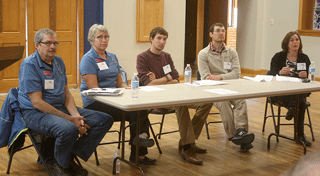May 6, 2019 at 11:02 a.m.
Plan of local attack reviewed at invasive phragmites workshop
The invasive weed/reed species is thriving.
Phragmites has a growing cycle that’s a little “out of whack” with Minnesota natives, explained U of M phragmites expert Julia Bohnen. The flowers come in late fall. You want to apply herbicide later in summer, when “translocation” of nutrients within the plant is happening.
While there are multiple scientific papers describing summer use of chemicals, Bohnen said the U is recommending later summer/fall application for prime chemical deadly effects on tissues. The two chemicals shown most effective have been glyphosate and imazapyr. A professional applicator needs to be consulted.
Attendees at the April 24 session on phragmites eradication planning for Chisago County, learned that the MN Department of Agriculture classifies the problematic phragmites as “a restricted noxious weed.”
For local authorities to have the power to order its removal it needs to be classed in a more serious category a “prohibited” plant.
The presenters said the county board can add phragmites to a local prohibited list for the same effect, but ideally the state needs to take a comprehensive approach. As a prohibited plant property owners would be mandated to eradicate it.
Chisago County is not waiting around for the legal term to be debated and it is advancing a plan to address 88 sites where phragmites populations are known.
Statewide there are 388 populations or clusters mapped.
A certified invasive species detector Mary Kay Ripp, who is a Chisago Lake property owner and volunteers in the phragmites effort here, spoke about the Chisago Lakes Lake Improvement District three year plan.
Ripp said, “We are really lucky for the level of collaboration locally, people understand the impacts of phragmites.”
An identification effort will be happening at the same time as the LID mechanical and chemical response. If you think you have phragmites on your property, first it needs to be verified as there are native plants that look similar, but don’t have the invasive nature.
Gary Schumacher, also with the Lake Improvement District, said the LID has some funds to aid in phragmites eradication, it is a 90-10 cost share. Landowners should work through their closest lake association, he added. There is an early detection (EDmap) app for mobile phones, that you can check with first to see if your phragmites population is already known. If it’s not on the app you can upload details. Field researchers like Bohnen, review this data and verify it.
The St Croix River Association is also involved.
It contracted with the LID for about $3,000 to do roadside inventory sweeps too. Lakeshore is being inspected and scrutinized well. This agreement is for 201 miles of city, township and other road miles inside the LID, to be checked for invasive phragmites.
Another component of the collaboration behind this effort is the Chisago County Soil and Water Conservation District. It will assist in replanting expertise. The agriculture sector is prioritizing the nasty weed, Palmer amaranth, currently.
Bohnen, from the University, said Chisago County is fortunate in that local response is gearing up early in the “invasion curve.”
She said Wisconsin found itself tackling stands of well-established phragmites that were miles long and acres wide, needing expensive helicopter chemical applications for some sites.
Chisago County is at the stage where an ATV with a chemical tank, or backpacks carrying sprayers will suffice.
“Things are still on the bright side in Minnesota, but there also needs to be a statewide response,” she said.
For the official website go to MNPhrag.org.
A success story
A resident on Turtle Lake in Ramsey County shared the successful eradication effort undertaken there by the Turtle Lake Homeowners’ Association, beginning in 2014 with the first mechanical harvest.
Kevin Ousdigian said Turtle Lake had a few years of very low water levels, similar to the Chisago Chain, which he thinks “opened the door” for spread of phragmites on open exposed shoreline.
Key things to look for in deciding if your stand is invasive or a native species; are the color of the stem and thickness of the stalk. Invasive phragmites has a reddish hue in the stalk and the vegetation is very tough.
He also recommended a tool called an aquatic vegetation groomer (sort of a super heavy duty weedwhip) that cuts just below the lake bottom. It costs about $800, but was very effective at cutting back small re-growth.




Comments:
Commenting has been disabled for this item.